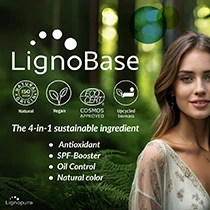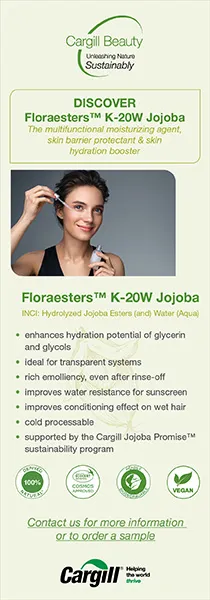Fragrance industry hits back at research flagging “hundreds of hazardous chemicals” in cleaning products

18 Sep 2023 --- Overseeing fragrance manufacturing and use in North America, the Fragrance Creators Association has responded to “unsettling details” found in a peer-reviewed study by the non-profit Environmental Working Group (EWG) on the potential health risks of common household cleaning products.
The study analyzed 30 products, including multipurpose and glass cleaners, air fresheners, bathroom cleaners, stain removers and more, flagging that these products release “hundreds of hazardous” volatile organic compounds (VOCs).
“This study is a wake-up call for consumers, researchers and regulators to be more aware of the potential risks associated with the numerous chemicals entering our indoor air,” states Alexis Temkin, Ph.D., a senior toxicologist at EWG.
“Our findings emphasize a way to reduce exposure to hazardous VOCs – by selecting products that are ‘green,’ especially those that are ‘green’ and ‘fragrance-free.’”
Scent manufacturers back safety of ingredients EWG researchers detected 530 unique VOCs in the 30 products, of which 193 were hazardous.
EWG researchers detected 530 unique VOCs in the 30 products, of which 193 were hazardous.
In response, the Fragrance Creators Association argues that VOCs are valuable and not all compounds are harmful.
“VOCs play an important role in enriching how we experience the world. Without them, we would not smell fresh cut grass, the beauty of a rose, the buttery scent of baking bread or the tang of lemonade,” reads the statement.
“VOCs have always been present in the environment and come from various sources, including natural sources and cleaning products. Fragrance ingredients – both lab-created and natural (like essential oils) – constitute only one potential source of VOCs in cleaning products.”
Moreover, they clarify that the presence of VOC does not always represent a danger to consumers “in the same way that the mere presence of an ingredient in a product does not necessarily pose a risk.”
“VOC-contributing ingredients are abundant: acetic acid is in vinegar, acetaldehyde is found in butter and beer, and limonene can be found in the rind of lemons, oranges and limes,” continues the association.
Pollution and health dangers detected
However, EWG researchers detected 530 unique VOCs in the 30 products, of which 193 were hazardous. These were identified as “having the potential to cause health harms such as respiratory system damage, increased cancer risk and developmental and reproductive impacts.”
“These cleaning products may hurt our health, but they may also harm the environment,” says EWG senior director of cleaning science Samara Geller.  (Image credit: EWG study).
(Image credit: EWG study).
The researchers highlight that VOCs in cleaning products have a negative impact on indoor and outdoor air quality.
VOCs pollute indoor air two to five times more than outdoor air. Some estimates are as high as ten times more, according to EWG.
Based on broader research, EWG shares that cleaning industry workers face a 50% higher risk of developing asthma and a 43% higher risk of chronic obstructive pulmonary disease. “Women working in this field also face an increased risk of lung cancer.”
Moreover, children face a greater risk of asthma and wheezing due to indoor cleaners, according to some studies found by EWG.
Regulation and fragrance benefits The Fragrance Creators Association is willing to meet with the EWG to engage in meaningful dialogue.
The Fragrance Creators Association is willing to meet with the EWG to engage in meaningful dialogue.
Fragrance Creators Association assures that “fragrances are some of the most highly tested ingredients in the marketplace, and are subject to many state and federal laws.”
“Our industry abides by guidelines backed by data from the Research Institute for Fragrance Materials, which performs safety assessments for human health and the environment on all fragrance ingredients. Our members strive to ensure that products containing fragrance are safe for people and the environment when used as intended,” it maintains.
Furthermore, the association explains that fragrances are present in cleaning products for a “vital” reason: they encourage cleaning and sanitization based on whether unpleasant odors have been replaced with pleasant smells.
“A study published in Cognitive Research: Principles and Implications presents a three-factor benefits framework for fragrance in household products – noting that fragrance in cleaning products provides functional benefits (malodor mitigation, base odor coverage and freshening), in-use experience benefits (cleanliness, efficacy and pleasure) and emotional benefits (increase in confidence, mood and nostalgia),” adds the association.
Further steps
The EWG study found that products labeled “green” emitted fewer VOCs – about half the number, on average, and green “fragrance-free” products produced VOCs nearly eight times fewer than conventional and four times fewer than green products, which included a fragrance label.
“Going green with your cleaning products is an easy way to reduce exposure to harmful chemicals. This may be especially important for women’s and children’s health,” adds Geller.
When studying hazardous VOCs, green products emitted only four on average compared to 15 in green products with fragrance and 22 for conventional products.
Meanwhile, Fragrance Creators aims to continue reviewing the study and provide more context to its findings.
“We invite the authors of the paper, and the EWG more broadly, to meet with fragrance industry representatives so we can share more about our work, listen and learn directly from them, and have a meaningful dialogue in this area,” they conclude.
In related news, the European Commission published Regulation 2023/1545, which pinpoints fragrance allergens that affect humans, which were previously not subject to individual labeling requirements.
By Venya Patel













